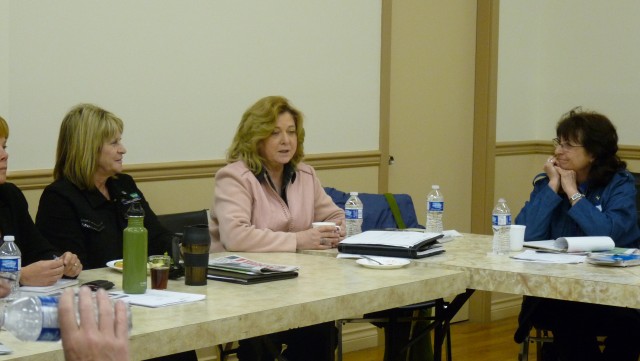Local chambers of commerce take next steps to regionalization
The Chamber of Commerce of the City of Grand Forks, the largest chamber group in the Boundary region, was first off the mark to agree to look at how the Boundary region businesses could create a region-wide chamber. The third meeting of the regional groups and local government representatives, hosted by the Boundary Economic Development Committee (BEDC) in Greenwood last Thursday, Apr. 1, to discuss moving forward with amalgamation saw an agreement between the area’s business organizations to take the next step.
Although there were many questions about the implications of moving to a regional model, the different representatives from the current chambers and local business groups were very interested in the opportunity of working more collaboratively.
Wendy Darbyshire, president of the Christina Lake Chamber, gave her strong support to developing a regional chamber of commerce.
“If we can all work together at the regional level for things that affect the whole Boundary, it is obviously essential. We’re all struggling to get people out, to get directors and membership out to meetings – everybody’s busy. At Christina Lake we’re all operators and nobody has the time to do everything all by themselves,” said Darbyshire. “In the smaller scope we can all look after ourselves, but to have a representative or two in a group working together for the overall Boundary is the way to go.”
The day long workshop started with a presentation from Kerry Rakuson, a director of the B.C. Chamber of Commerce and Nelson Chamber of Commerce, about the benefits of chambers and their typical activities. Rakuson gave details to the group about funding and membership fee structures, the difference between boards of trade and chambers, and the amalgamation process. With existing chambers, the choice would be to close all chambers and create a new one, or amalgamate into one chamber, but the process for amalgamation is much more time consuming, said Rakuson.
Bonny Dancy from the South Okanagan Regional Chamber of Commerce went on to encourage an open discussion about the process of amalgamation and her experience in the South Okanagan when they decided to join forces as chambers. Dancy said that when the idea of amalgamation was put to a vote, their region’s 360 business members the voted unanimously in favour. Their main focus as a chamber has been on business networking and training, events, and projects that are of importance to the different communities. With two full-time staff, the regional chamber is able to provide support that their members value.
Jim Nathorst, with the Greenwood Board of Trade, questioned the need to amalgamate or dissolve organizations. He suggested that the collaboration could continue in an informal structure with regular meetings and event planning.
“I’ve made it pretty clear I am anti-bureaucratic. What intrigues me is that, we’ve had three meetings and we’ve managed to have representation at the table from all of the West Boundary at every meeting,” said Nathorst. “So my thinking is, if we can do that without an organization, why can’t we just keep doing it three or four times a year – exchange ideas, and share events? We can do all that without an organization, without a body.”
but Chair of the BEDC and Regional Area C Director Grace McGregor stressed the importance of moving beyond protectionism for the communities and businesses and to look at what will be the best for all.
“(We need) to talk about the big picture because the big picture will bring the people in your restaurant’s front door. It’s hard for us to move positions because we’ve been in the old position for so long fighting to try and keep our head above water,” said McGregor. “You’re here because you believe there’s a reason to be here.”
By the end of the day, the group agreed to work as a committee to formulate an information package and a question to put to members of the individual organizations. Community Futures Boundary offered to provide staff support to the group as they move forward in exploring the regional idea, as well as funding support of up to $10,000.
Anne Rexin, part of the Discover Rock Creek group, said that their group is committed to the initiative.
“We wouldn’t be here from the West Boundary if we weren’t interested,” said Rexin. “This here’s a chance to jump on board, sell our community and to hook on to the train that’s going. We don’t want it to leave the station without us.”
Business groups who participated at the meeting were: the Greenwood Board of Trade, the Chamber of Commerce of the City of Grand Forks, Christina Lake Chamber of Commerce, and Discover Rock Creek, a fledgling business group primarily creating visitor information. Government representatives from across the region and each city also came to the table to support the shift to a regional approach.






















